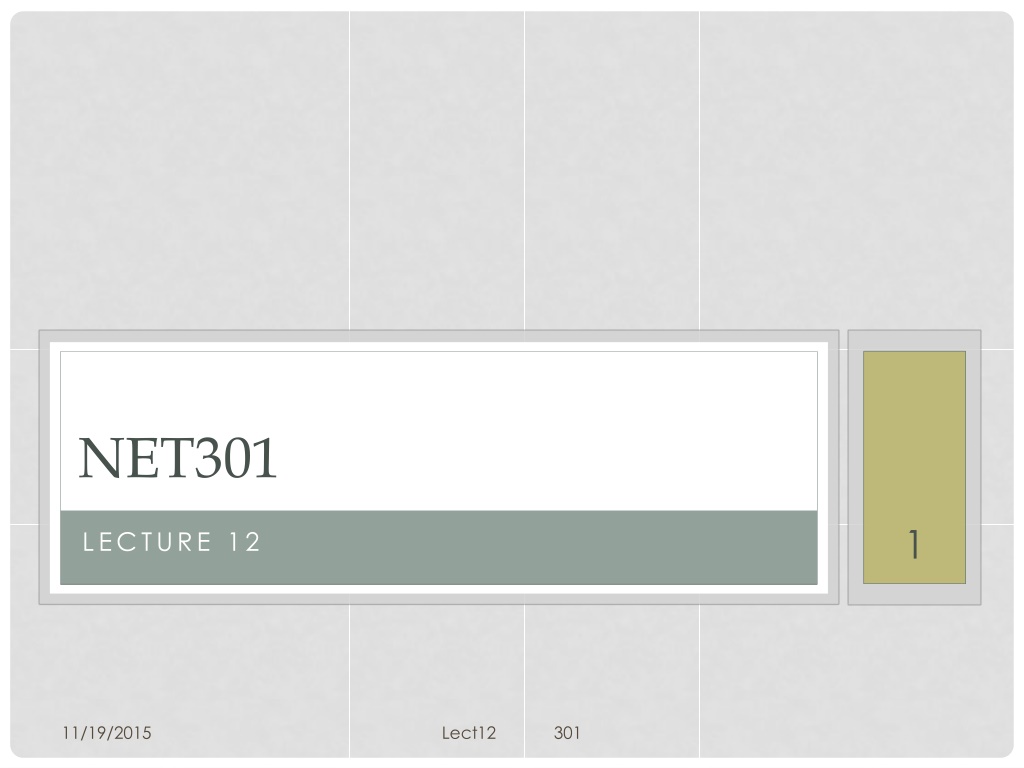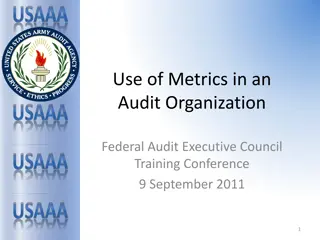Understanding Network Performance Metrics in Telecommunications
This content delves into the realm of network performance measurement in telecommunications, focusing on metrics that impact service quality as perceived by customers. It covers a range of topics including network performance measures, system performance metrics, bandwidth, throughput, latency, error rates, and end-to-end delay. The emphasis is on understanding how to quantify and evaluate different aspects of network performance effectively.
Download Presentation

Please find below an Image/Link to download the presentation.
The content on the website is provided AS IS for your information and personal use only. It may not be sold, licensed, or shared on other websites without obtaining consent from the author. Download presentation by click this link. If you encounter any issues during the download, it is possible that the publisher has removed the file from their server.
E N D
Presentation Transcript
NET301 1 LECTURE 12 11/19/2015 Lect12 301
NETWORK PERFORMANCE measures of service quality of a telecommunications product as seen by the customer Can I measure everything? Impact on devices (measurements and measuring) Balance between amount of information and time to get it 11/19/2015 Lect12 301 2
METRICS Network performance metrics Channel capacity, nominal & effective Channel utilization Delay and jitter Packet loss and errors 11/19/2015 Lect12 301 3
METRICS System performance metrics Availability Memory, CPU Utilization, load, I/O wait, etc. Service performance metrics Wait time / Delay Availability How can I justify maintaining the service? Who is using it? How often? Economic value? Other value? 11/19/2015 Lect12 301 4
PERFORMANCE MEASURES Bandwidth commonly measured in bits/second is the maximum rate that information can be transferred Throughput is the actual rate that information is transferred 11/19/2015 Lect12 301 5
PERFORMANCE MEASURES Latency the delay between the sender and the receiver decoding it, this is mainly a function of the signals travel time, and processing time at any nodes the information traverses Jitter variation in the time of arrival at the receiver of the information 11/19/2015 Lect12 301 6
PERFORMANCE MEASURES Error rate the number of corrupted bits expressed as a percentage or fraction of the total sent 11/19/2015 Lect12 301 7
END-TO-END DELAY The time required to transmit a packet along its entire path Created by an application, handed over to the OS, passed to a network card (NIC), encoded, transmitted over a physical medium (copper, fibre, air), received by an intermediate device (switch, router), analyzed, retransmitted over another medium, etc. The most common measurement uses ping for total round-trip-time (RTT). 11/19/2015 Lect12 301 8
TYPES OF DELAY Causes of end-to-end delay: Processor delays Buffer delays Transmission delays Propagation delays 11/19/2015 Lect12 301 9
PROCESSING DELAY Required time to analyze a packet header and decide where to send the packet (eg. a routing decision) This can include error verification 11/19/2015 Lect12 301 10
QUEUING DELAY The time a packet is enqueued until it is transmitted The number of packets waiting in the queue will depend on traffic intensity and of the type of traffic Router queue algorithms try to adapt delays to specific preferences, or impose equal delay on all traffic. 11/19/2015 Lect12 301 11
TRANSMISSION DELAY The time required to push all the bits in a packet on the transmission medium in use For N=Number of bits, S=Size of packet, d=delay d = S/N 11/19/2015 Lect12 301 12
PROPAGATION DELAY Once a bit is 'pushed' on to the transmission medium, the time required for the bit to propagate to the end of its physical trajectory The velocity of propagation of the circuit depends mainly on the actual distance of the physical circuit In the majority of cases this is close to the speed of light. For d = distance, s = propagation velocity PD = d/s 11/19/2015 Lect12 301 13
PACKET LOSS Occurs due to the fact that buffers are not infinite in size When a packet arrives to a buffer that is full the packet is discarded. Packet loss, if it must be corrected, is resolved at higher levels in the network stack (transport or application layers) Loss correction using retransmission of packets can cause yet more congestion if some type of (flow) control is not used (to inform the source that it's pointless to keep sending more packets at the present time) 11/19/2015 Lect12 301 14























